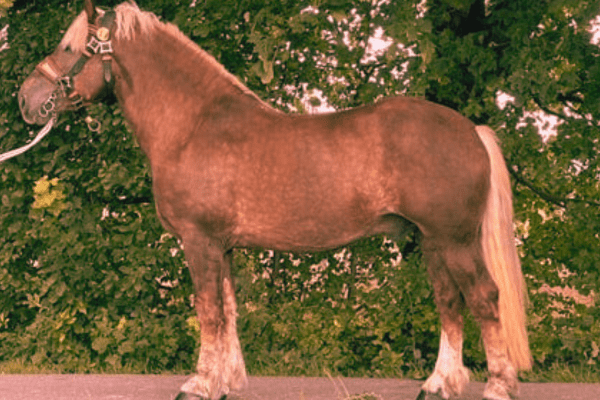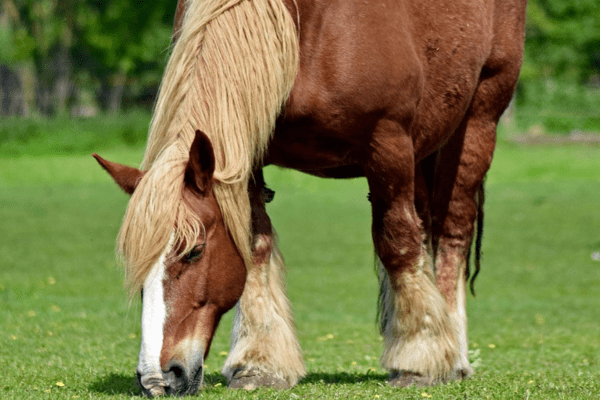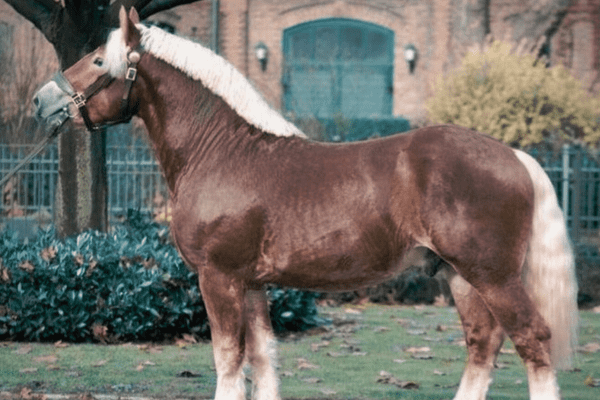The South German Coldblood stands as a testament to the rich equine heritage of Southern Germany. This breed, closely related to the Noriker horse, is the most prominent among the quartet of major German draft horses. Historically pivotal in transporting essentials through challenging mountainous landscapes, their role has evolved over time.
Nowadays, these majestic horses are more commonly seen gracing shows and parades, and occasionally partaking in agricultural activities. Their contribution extends beyond their immediate utility, as they have played a significant role in the refinement and creation of various other horse breeds within Germany, showcasing their enduring legacy and versatility.
History:
The South German Coldblood stands out as an intriguing breed within European draft horses. Here is an extended, point-by-point account of its beginnings, development, and current standing:
Genetic Distinction and Relation with Noriker Breed:
Shared Ancestry with Noriker: South German Coldbloods share an ancestry with Austrian Noriker breed, though both have developed as separate entities over time.
Genetic Analysis: Studies conducted have demonstrated that South German Coldblood dogs differ not only from other German draft breeds but also from Noriker populations in Salzburg and Carinthia – likely as a result of Thoroughbred and warmblood genetic influences being introduced during crossbreeding efforts.
Historical Development
Early Recognition: The breed first gained formal recognition in 1906 with the establishment of a stud book for Bayerisches Oberland region of southern Bavaria.
Stud Book and Branding: Closing the Stud Book and Adopting Edelweiss as Breed Icon were instrumental in creating its distinct identity.
Breed Classification and Evolution
Initial Classification: Historically, this breed was divided into two types; Oberlanders were lighter in build while Pinzgauers weighed heavier, similar to classification used in Austria.
Unification of Classification: By 1939, this distinction had been eliminated and all horses collectively known as Noriker were collectively classified.
Adoption of Current Name: In 1948, this breed officially earned the name ‘Suddeutsches Kaltblut’ to reflect its unique standing among European breeds.
Stability and Preservation in Population Management
Population Trends: Since the late 20th century, the breed has maintained a stable population. In 2013 alone, 1,921 mares and 129 stallions made up 2,050 individuals totalling 2.
Preservation Efforts: These figures highlight the ongoing efforts to protect and promote this breed, reflecting its ongoing relevance and appeal.
Modern Day Relevance
Continued Utility: Once prized for transport and agricultural tasks, South German Coldblood horses now find greater utility as show horses or parade floats; some still remain relevant in certain agricultural contexts.

Characteristics:
The South German Coldblood, known for its robust constitution, exhibits some distinguishing traits and susceptibilities within equine health. While possessing distinctive physical traits, this breed also displays predisposition towards certain bone diseases – for more information, here’s an in-depth breakdown:
Distinctive Coat Patterns
Leopard/Tiger Spotting: One of the many fascinating traits of South German Coldblood dogs is their occasional display of leopard or “tiger” spotting – an uncommon yet striking coat pattern which further distinguishes this breed.
Susceptibility to Bone Diseases :
Prevalence of Osteochondrosis and Osteochondritis Dissecans: This breed is particularly prone to osteochondrosis and osteochondritis dissecans – conditions which impact bone and cartilage development – making them susceptible to diseases that interfere with their normal functions.
Significant Research Findings: A comprehensive study with 167 young horses, average age 14 months old, revealed a high incidence of osteochondritic lesions and osseous fragments among them. Osteochondritic lesions were present in 61.7% of these horses’ fetlock/hock joints while 28.9% showed evidence of such issues.
Gender and Age Disparities: Studies revealed that incidence rates were twice as high among fillies compared to colts, with symptoms more frequently appearing among horses aged one year or older.
Genetic Factors
Scientists have recently discovered three SNPs associated with osteochondritis dissecans in fetlock joints of these horses. These SNPs offer insights into its genetic basis and may help steer future breeding practices.
Implications
Breeding and Health Management: These findings illustrate the significance of providing proper breeding practices and health management practices to South German Coldblood horses. Furthermore, regular veterinary visits and genetic screening could help detect and manage any conditions effectively.
Continued Research and Awareness: For the long-term wellbeing and preservation of this unique breed, ongoing research and increased awareness are both key.
Temperament:
One of the hallmarks of the South German Coldblood horse breed is their gentle yet relaxed disposition, often described as easygoing or laidback. These horses are known for being known for their easygoing personality and easy grooming needs.
Uses:
Agricultural Work: Long used in Southern Germany for farming and heavy haulage purposes, they have long played an essential role in its agricultural development.
Recreational Riding: Recently these horses have also become very popular recreational riding options due to their gentle temperament and steady gait.
Competitions: They are increasingly featured in various equestrian competitions, showcasing their versatility and trainability.

Conservation and Breeding:
Breed Conservation and Breeding : In recent times, efforts have been taken to preserve breeds as agricultural mechanization reduces the need for heavy workhorses.
Selective Breeding: Breeders strive to preserve the characteristics of each breed they raise, such as strength, calmness and adaptability.
Cultural Impact:
Cultural Significance: In Southern Germany, the South German Coldblood holds a special place in cultural heritage, often featured in local festivals and parades.
Symbol of Tradition: The breed is a symbol of the rural traditions and the historical agricultural practices of the region.
Modern Day Scenario:
These horses have become part of modern life through adaptation, from leisure riding to therapeutic horsemanship. Popularity: Although not as widespread, these breeds still maintain a large following among horse enthusiasts who value their unique qualities.

